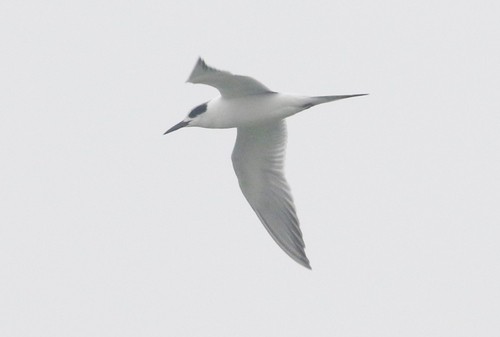Forster's Tern
A species of Typical Terns Scientific name : Sterna forsteri Genus : Typical Terns
Forster's Tern, A species of Typical Terns
Botanical name: Sterna forsteri
Genus: Typical Terns
Content
Description General Info
 Photo By silversea_starsong , used under CC-BY-NC-4.0 /Cropped and compressed from original
Photo By silversea_starsong , used under CC-BY-NC-4.0 /Cropped and compressed from original Description
Forster's tern is a medium-sized tern with a slender body, deeply forked long tail and relatively long legs. In its non-breeding plumage, the crown is white and a black comma-shaped patch covers the eye and the ear-covert. The wings are grey with the primaries being dark silver grey, while the underside is white. The bill is black and the legs are a dull brownish red. When breeding, an intense black cap extending down the neck appears. The wings and the back are pale grey while the underside is bright white. It has a black-tipped orange bill and bright orange legs. The juveniles have coloring similar to a non-breeding adult but often have darker primaries. 
Size
36-38 cm (14-15 in)
Colors
Black
Gray
White
Life Expectancy
12 years
Nest Placement
Floating
Clutch Size
1 - 4 eggs
Incubation Period
1 brood
Number of Broods
23 - 28 days
Nestling Period
2 - 7 days
Feeding Habits
Forster's Tern primarily feeds on small fish through plunge-diving from heights up to 50 feet and sometimes hunts from perches, capturing prey up to a foot underwater. Diet includes various fish species and insects; in some regions, it includes juvenile Pacific lamprey and crustaceans. Forster's Tern prefers turbid water, likely due to prey density and behavior includes aerial swallowing and prey manipulation before consumption.
Habitat
Forster's Tern's preferred habitats include extensive wetlands, marshes, and coastal regions at sea level, favoring environments from freshwater to saltwater. During breeding, forster's Tern forms colonies on marsh edges or adjacent beaches. They select habitats with stable water levels and minimal disturbance. Post-breeding, forster's Tern migrates to oceanic coasts and various wetlands, with wintering in southern marshes, coastal estuaries, and roosting on beaches and mudflats.
Nest Behavior
Forster's Tern's nesting includes ground-based nest building, with variation in construction from simple scrapes to lined bowls.
Nest Characteristics
Forster's Tern's nests are typically found in marsh vegetation, weeds, and dead vegetation piles, sometimes floating or on muskrat lodges. The nest can be a simple ground scrape or a bowl constructed from marsh plants like bulrush, cattail, or sedge, measuring about 7 inches across with an inner cup of 5 inches across and 1 inch deep.
Dite type
Piscivorous
General Info
Feeding Habits
Bird food type
Sounds
Call
Recording location: United States
Behavior
Forster's Tern exhibit notable courtship rituals, such as synchronous high flights, slow wingbeats, and coordinated descending maneuvers, often with the male presenting a fish. These displays also occur with aerial hoverings and ground parades within their colonies. Their courtship includes a unique 'courtship feeding' where males offer fish to females. Forster's Tern share both incubation responsibilities and territorial defense of their small nests. They engage in a range of defensive behaviors, from vocalizations to physical confrontations. Post-fledging, forster's Tern families may migrate together. In nonbreeding seasons, they're gregarious, foraging and roosting in groups on coastal substrates.
Distribution Area
Forster's tern is a marsh dwelling species. It can be found either in freshwater, brackish or saltwater. It is often found over shallow open water deep in the marsh. Main habitats are marshes, estuaries, islands, salt marshes and marshy areas surrounding lakes and streams. Forster's tern is usually restricted to North America. It nests in marshes during the summer, either on the Atlantic or Pacific coast, but also in the Prairies or along the Great Lakes in Canada and the US. Due to the instability of its nesting habitat, Forster's tern exhibits a high annual turnover rate. Forster's tern also winters in marshes along the southern coast of the US and Mexico but can sometimes reach the northern extremity of Central America. It is also common for the tern to winter in the Caribbean. It can annually visit Western Europe and has occasionally wintered in Great Britain and Ireland. 
Species Status
According to the IUCN, the status of the Forster's tern is of little concern, however, degradation of marsh habitat may be threatening. Boating activity may also affect nest vegetation and increase erosion, which may lead to further degradation of tern nesting grounds. Excessive noise may also have caused nest desertion and chick mortality. This species is listed under the Migratory Birds Treaty act in the U.S. It is endangered in Illinois and Wisconsin while being of special concern in Michigan and Minnesota. Preservation of wetlands and introduction of artificial nesting sites may help preserve the species in high-risk areas (). Increasing populations of carp in drainage systems, causing damages to marsh vegetation may limit habitat availability for Forster's tern. There have also been anecdotal reports of intense spawning activity of carp damaging tern's floating nests. As with many species of piscivorous birds, Forster's tern is susceptible to bioaccumulation of pollutants. High mercury concentration may induce biochemical stress, reducing the overall health of terns. Biomethylation of mercury is increased in marshes and salt ponds, hence increasing the susceptibility of the Forster's tern. High levels of Selenium may also have deleterious effects on their health. Organochlorine contaminants such as PCB may also diminish their breeding success. 
Scientific Classification
Phylum
Chordates Class
Birds Order
Shorebirds Family
Gulls Genus
Typical Terns Species
Forster's Tern